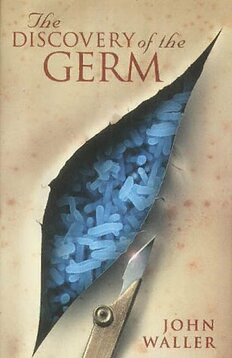
The Discovery of the Germ PDF
207 Pages·2002·2.325 MB·English
Most books are stored in the elastic cloud where traffic is expensive. For this reason, we have a limit on daily download.
Preview The Discovery of the Germ
Description:
With the ever present threats of bioterrorism and pandemics together with increasing rates of antibiotic resistant infections, this book should be of interest to many readers. As such, I found it a delightful, well-written, easy-to-read, brief introduction to the subject. The author clearly shows the difficulties experienced, scientific, theoretical and cultural, in establishing the role of germs in infectious diseases. Those opposing the role of germs are shown in many cases to have been reasonable and rational in their opposition. Many of the scientific, both laboratory and epidemiology, approaches that we take for granted today were truly creative, innovative, risky, and difficult for the early pioneers. However, I found it irritating that the book lacked an index, something I often use in finding subjects and people. I also found a couple of inconsequential minor errors. On page 190, he writes "the sulphonamides developed by Paul Ehrlich . . ." Ehrlich developed the first successful treatment for bacterial infections, syphilis and sleeping sickness; but the treatment was a variant of arsenic (his 606th tweaking of the molecule) which he named Salvarsan. German chemists during the 19th Century discovered in staining tissues for histological examination that different stains attached to different tissues. Ehrlich hypothesized that if a compound could be made that selectively targeted a disease causing organism, then a toxin could be attached to the compound, hence, a "magic bullet" would be created that killed only the organism targeted. In 1932, 17 years after Ehrich's death in 1915, Gerhard Domagk developed the first sulphonamide which successfully treated streptococcal infections for which he received the Nobel Prize in 1935. Again on page 190, the author writes, "How many of us would have gone to an early grave, were it not for the formulation of vaccines like the anti-tuberculosis jab?" The only vaccine currently used against tuberculosis, the BCG, Bacillus Calmette-Guérin, has been shown to be effective against miliary tuberculosis, a severe form found in infants and the elderly, and tubercular meningitis found in children. The verdict as to its effectiveness for preventing pulmonary tuberculosis is unclear. For those interested, I strongly recommend Frank Ryan's book, "The Forgotten Plague: How the Battle Against Tuberculosis Was Won - And Lost." There is also a quite informative article on the Bacillus Calmette-Guérin vaccine in the free online encyclopedia, Wikipedia. The errors above in no way diminish the overall strengths of the book.
See more
The list of books you might like
Most books are stored in the elastic cloud where traffic is expensive. For this reason, we have a limit on daily download.
